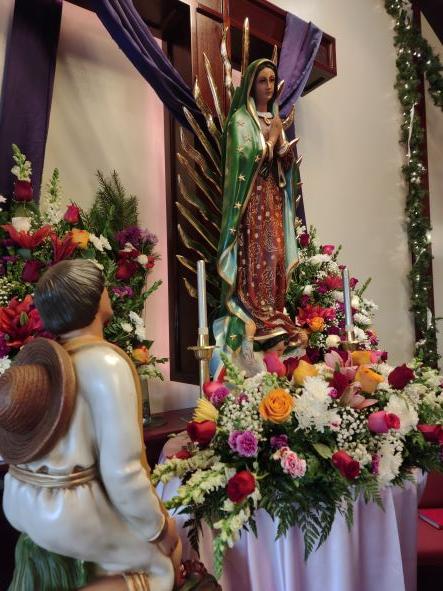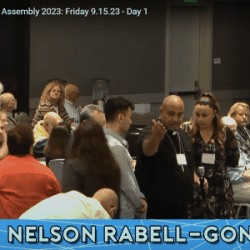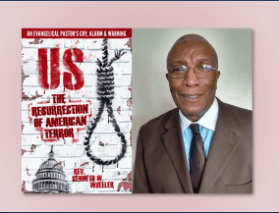Iglesia Luterana Santa Maria Peregrina finds healing and hope on El Día de La Virgen de Guadalupe – one year after an ELCA bishop removed their pastor and invaded their sacred celebration.

The morning began for me with a rainbow. I looked out of my hotel room to see an arc of color across the grey sky just beginning to clear from a night of rain. This is a good sign, I thought.
It’s a reminder of God’s promise. A reminder of hope.
I had traveled to the Central Valley of California to be with Rev. Nelson Rabell Gonzalez and his congregation, Iglesia Luterana Santa Maria Peregrina. They were planning a worship service for El Día de La Virgen de Guadalupe, the Feast Day of the Virgin of Guadalupe, on Sunday, Dec. 11. It was one year after former bishop Megan Rohrer removed Rev. Nelson as their pastor and invaded their sacred celebration.
On that day in 2021, the people refused to submit to what they believed was a racist, colonizing, unjust violation of their congregation and pastor. When they were told to be quiet and wait, they picked up the statue of the Virgin, the flowers, and the cross, and peacefully marched out of the sanctuary. They walked nearly two miles that day through a cold drizzle to Centro de Lucha Pro Immigrante de Stockton to finish the worship service.
[Read about the events of that day here: The Day an ELCA Synod ‘Disappeared’ Pastor Nelson Rabell-González.]
Two months later, under a barrage of unsubstantiated accusations and rumors, Rev. Nelson was removed from the roster of ordained ministry in the ELCA without due process or chance for appeal.
Still processing the trauma
“I have to admit, I still have a lot of PTSD from that day. So does my family,” Rev. Nelson told me a few days before the service.

He was driving me and two ELCA bishops to the church where he and his congregation had been worshiping last year. Bishop Idalia Negron of the ELCA’s Caribbean Synod and her husband Roberto, along with Bishop Leila Ortiz of the Metro D.C. synod, had also come a few days early to spend time with Rev. Nelson before El Día de La Virgen de Guadalupe. Two other Latino bishops also came to support their brother in Christ, Bishop Felix Malpica of the La Crosse (WI) Area Synod, and The Rev. Dr. Rafael Malpica Padilla Executive Director for the ELCA Service and Justice Home Area and former bishop of the Caribbean Synod.
Rev. Nelson wasn’t the only one reliving the trauma of the previous year. At the Saturday dinner graciously hosted by a member of Santa María for a gathering of bishops and representatives of the ELCA, along with members Santa Maria’s leadership and many of us who have supported them along the way, I learned that some felt a sense of foreboding about the next day’s worship service. What if some bad actors showed up to cause trouble?
That fear has a credible source.
The Central Valley is known for its white nationalist activity. In light of Rev. Nelson’s activism on behalf of the migrant and immigrant population in Stockton and Lodi, some were concerned that he – and his congregation – might be targeted once again. In fact, one of the pastors who had planned to attend was unable to come because his own congregation in Fresno was dealing with a group of white nationalists threatening their church for supporting the LGBTQIA+ community and antiracism.
Fortunately, however, El Día de La Virgen de Guadalupe at Iglesia Luterana Santa Maria Peregrina proceeded with splendor, joy, and grace, free from the terror of last year.
Terror? That word may seem to be a bit extreme to some.
But remember that a subsequent investigative report by an ELCA panel revealed that Rohrer had shown up to the service last year wearing a bullet-proof vest and made a racist threat against a 10-year-old Latina child.
[Read about the Panel’s report here: Bishop Rohrer Threatened Latina Child, ‘Racist Verbal Assault’: ELCA Listening Team Report.]
“My daughter didn’t want to come to church for a long time after that,” the girl’s father told me when I talked to him Saturday evening. “But she will be there tomorrow,” he assured me.
She was joined by many, many other children and teens for El Día de La Virgen de Guadalupe at Iglesia Luterana Santa María Peregrina. By the grace of God, the congregation has emerged from their diaspora bursting with families drawn to the congregation for its Spanish-language service. They also come because Rev. Nelson offers free classes for First Communion and Confirmation. (This is in contrast with the local Roman Catholic Churches that charge for these services.)

On Dec. 11, Rev. Nelson baptized an adorable baby girl, celebrated the Affirmation of Baptism with seven confirmands, and gave First Communion to ten niños y niñas receiving the sacrament for the first time that day.
How has Iglesia Luterana Santa Maria Peregrina not only survived but thrived after the previous year’s trauma?
After being abandoned by the ELCA, the congregation stayed together to incorporate as the first independent Lutheran church in the state of California. With Rev. Nelson as their pastor, they chose their name, Lutheran Church of St. Mary the Pilgrim, in honor of her accompaniment as they moved to three different locations over the past four years.

The congregation began as an outreach ministry at St. Paul Lutheran Church in Lodi in 2018. That was when Rev. Nelson was called as the Associate Pastor to begin a Spanish-language worship service and ministry. But his outspoken antiracism work and community activism on behalf of undocumented agricultural workers led the senior pastor and church leadership to oust him in 2021. Nevertheless, the bishop at the time, Rev. Mark Holmerud, authorized Rev. Nelson to begin a new mission start in Stockton, about a 30-minute drive from Lodi.
That was the congregation’s second stop on their pilgrimage.
To complicate matters, the previous intern was given Rev. Nelson’s previous position at St. Paul. But the Latiné congregation did not stay. Instead, they began worshiping at Rev. Nelson’s new mission start, Misión Latina Luterana.
There are many reasons for this exodus, which you can read about here: Why the ELCA Needs to Investigate the Case of Rev. Nelson Rabell-González . But to make a long story short, a certain individual at St. Paul was harassing Latina women in Rev. Nelson’s congregation. So they wanted nothing to do with St. Paul. Rev. Nelson reported these accusations to the senior pastor and a congregational leader, and eventually to synodical leadership and even the Presiding Bishop of the ELCA. But no one would listen to him or to the women. Instead, they targeted him as the whistleblower.
A 19-month-long nightmare
The first attack came at the Sierra Pacific Synod Assembly in May 2021 when Rev. Nelson was a candidate for bishop. He learned that there were allegations of verbal misconduct made against him, which he chose to publicly disclose during the assembly. He also revealed that St. Paul tried to get him to sign a non-disclosure agreement to silence him. This began a 19-month-long nightmare for Rev. Nelson, his family, and his congregation that still has not been resolved.
The person who was elected bishop, Megan Rohrer, was themself involved in a lawsuit involving financial malfeasance at their previous congregation. However, they were not required to disclose this at the synod assembly. Nevertheless, Rev. Nelson hoped that Rohrer would help to resolve his dilemma. He reported the allegations of harassment that had been shared with him by his congregants and asked for a disciplinary process against himself so that the charges could be fully investigated.
Instead of following up on these allegations, however, Rohrer began a series of public and private rumors that Rev. Nelson had harassed multiple women. Since Rohrer’s eventual removal from office in June 2022, the current interim bishop, Rev. Claire Burkat, has discovered that the accusations were completely fabricated. The ELCA is now in an investigative process against Rohrer, and the Sierra Pacific Synod has undertaken an investigation into the accusations against Rev. Nelson.
We had hoped for a resolution to the process by the time of El Día de La Virgen de Guadalupe. However, the investigation is multilayered and is taking longer than expected.
[Read more about Rohrer’s legal liabilities here: Remove Bishop Megan Rohrer? Follow the Pattern, Follow the Money]
Nevertheless, the worship service on Dec. 11 was, in my observation, an important step in the process of healing and restoration.

After several weeks of worshiping in parks and members’ homes, Iglesia Luterana Santa María Peregrina began worshiping at a church in Stockton that graciously opened their doors to the beleaguered congregation. This has been the third stop on their pilgrimage. On Dec. 11, the sanctuary was nearly full for El Día de La Virgen de Guadalupe, and the service was a model of what the Realm of God should look like.
I thought to myself, this what it’s like when the Day of Pentecost meets El Día de La Virgen de Guadalupe — multicultural, multilingual, and multiracial.
The service began outside where an Aztec troupe prayed through dance, chanting, cleansing incense, and colorful, rhythmic outfits adorned with elaborate feathers and sacred symbols. It was like the rainbow I had seen earlier that morning had now danced its way into this sacred moment. (You can watch the whole service here.)

Why did Rev. Nelson invite the Aztec dancers? Because La Virgen de Guadalupe appeared to an indigenous peasant, Juan Diego, on Tepeyac Hill in Mexico City, Dec. 12, 1531. She spoke to him in his native language and promised her abiding presence on that sacred hill. Though the bishop initially refused to believe him (seeing a theme here?), the Virgin persisted with Juan Diego and made her presence known through a miraculous blooming of roses in the desert which left an impression of her visage on Juan Diego’s cloak when he brought the flowers to the bishop.

So when these Aztec dancers came to each one of us in the procession with the holy incense, and then honored the statue of the Virgin, it was like a sacred, healing bridge across both 491 years . . . and one single year. Rohrer had cut short the sacred dance last year. But this time the dancers could proceed with their full, solemn ritual unimpeded and with sacred reverence from everyone gathered.
Then the festive Mexican Mariachi band led us into the sanctuary.
It was a procession of bishops, pastors, lay leaders, adults, teens, and children all blessed by the music of yet another culture that bridged us across time and space. Over the next two hours, the Lutheran liturgy was led in Spanish and helpfully translated via closed-circuit headsets to the English-speakers in the congregation.

Rev. Nelson’s sermon was also a moment of bridge-building.
He noted the connection between the Lutheran faith and the practice of reverencing Jesus’s mother. “Father Martin Luther said that everything that belonged to Christ was ours, too. The Virgin Mary was his mother. Therefore, she is our mother in faith.” He continued, “The Virgin of Guadalupe was present in our midst a year ago when we marched against injustice, carrying her image along the streets of Stockton. That’s why we are called Santa María Peregrina.”
For my part, the congregation invited me to offer the prayers of intercession during the service.
One thing that has become important to me during this whole saga is trying to learn the language of this community. So with the help of Rev. Nelson and the Latino bishops who coached me in the translation and pronunciation, I led the prayers in Spanish. (You can read those prayers here.)
After the service, we all enjoyed a feast of Mexican dishes while listening to the rousing music of Córima, another mariachi band. By all accounts of everyone I talked with during the meal, this was a service of healing. It was a sign of hope.

The ELCA needs Iglesia Luterana Santa María Peregrina
ELCA Presiding Bishop Elizabeth Eaton visited Rev. Nelson and his congregation back in October and heard first-hand what the Latina women endured and what they all have suffered. Though she was not at the service on El Día de La Virgen de Guadalupe, she did send a letter that was read to the congregation. In the letter she noted that Mary’s appearance to Juan Diego was a manifestation of her song of God’s liberation for the oppressed while powerful colonizers are brought down.
“This is a message of hope, hope based on God’s steadfast promises. I believe that it is this hope that has carried Santa María Peregrina through the past year. I pray this will truly be a day of celebration. You are a vibrant congregation and a witness to God’s faithfulness. The ELCA needs you.”
Indeed, this denomination that is 97% white with a history of racist practices does need Iglesia Luterana Santa María Peregrina and other diverse congregations. This is not just the church of the future. This must be the focus of the church right now.
After the investigation clears Rev. Nelson’s name (and I believe it will, because I’ve seen the evidence), the ELCA needs to fully restore him to his position as a rostered minister of Word and Sacrament. His congregation needs to be fully embraced – not as a mere “mission congregation” (a designation that makes them ecclesial second-class citizens) but as a church in its own right. And the denomination needs to follow through on its commitments to limiting NDAs, stopping the misuse and abuse of On Leave from Call Status, reforming the mission development process, and restructuring and reconstituting the denomination.
[Read about these churchwide memorials here: From a Moment to a Movement: Rev. Nelson Rabell’s Saga and the ELCA Churchwide Assembly.]
In the meantime, there will be more baptisms at Iglesia Luterana Santa María Peregrina. There will be more First Communions and more Affirmations of Baptisms. There will be more Quienceañeras (a coming-of-age celebration in Hispanic culture.) And there will be weddings and funerals, house blessings and fiestas. Also, there will be more efforts of advocacy and activism, putting faith into action.
Why? Because this congregation trusts their pastor, Rev. Nelson Rabell Gonzalez. They know him; they know his family. And they know the truth. And by God’s grace, they have faith that the truth will set them free.
May God’s truth free us all.
Read also:
Pastor Nelson’s Spouse Speaks: The Year of Pain
The ELCA Apology to Iglesia Luterana Santa María Peregrina: What Have We Learned?
White Fragility in the ELCA: 5 Things We Can Do About It

The Rev. Dr. Leah D. Schade is ordained in the ELCA. She does not speak for the ELCA; her opinions are her own. She is the author of Preaching in the Purple Zone: Ministry in the Red-Blue Divide (Rowman & Littlefield, 2019) and Creation-Crisis Preaching: Ecology, Theology, and the Pulpit (Chalice Press, 2015). She is the co-editor of Rooted and Rising: Voices of Courage in a Time of Climate Crisis (Rowman & Littlefield, 2019). Her newest book is Introduction to Preaching: Scripture, Theology, and Sermon Preparation, co-authored with Jerry L. Sumney and Emily Askew (Rowman & Littlefield, 2023).













